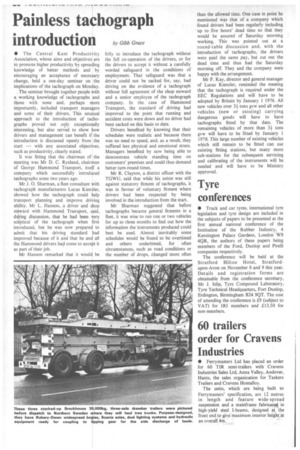Painless tachograph introduction
Page 32

If you've noticed an error in this article please click here to report it so we can fix it.
by Gibb Grace
• The Central Kent Productivity Association, whose aims and objectives are to promote higher productivity by spreading knowledge of better methods and by encouraging an acceptance of necessary change, held a one-day seminar on the implications of the tachograph on Monday.
The seminar brought together people with a. working knowledge of tachographs and those with none and, perhaps more importantly, included transport managers and some of their drivers. This unusual approach to the introduction of tachographs proved not only exceptionally interesting, but also served to show how drivers and management can benefit if the introduction is discussed openly from the start — with any associated objectives, such as productivity, clearly stated.
It was fitting that the chairman of the meeting was Mr D. C. Ryeland, chairman of George Hammond Transport, itself a company which successfully introduced tachographs some two years ago.
Mr J. 0. Sharman, a fleet consultant with tachograph manufacturers Lucas Kienzler, showed how the tachograph could help transport planning and improve driving ability. Mr L. Hanson, a driver and shop steward with. Hammond Transport, said, dining discussion, that he had been very sceptical of the tachograph when first introduced, but he was now prepared to admit that his driving standard had improved because of it and that he and all the Hammond drivers had come to accept it as part of their job.
Mr Hanson remarked that it would be folly to introduce the tachograph without the full co-operation of the drivers, or for the drivers to accept it without a carefully worded safeguard in the conditions of employment. That safeguard was that a driver could not be sacked for, say, bad driving on the evidence of a tachograph without full agreement of the shop steward and a senior employee of the tachograph company. In the case of Hammond Transport, the standard of driving had improved to the point that running and accident costs were down and no driver had been sacked on this basis to date.
Drivers benefited by knowing that their schedules were realistic and because there was no need to speed, and, as a result, they suffered less physical and emotional stress. Managers benefited by now being able to demonstrate vehicle standing time on customers' premises and could thus demand better turn-round times.
Mr R. Clayton, a district officer with the TGWU, said that while his union was still against statutory fitment of tachographs, it was in favour of voluntary fitment where drivers had been respected by being involved in the introduction from the start.
Mr Sharman suggested that before tachographs became general fitments in a fleet, it was wise to run one or two vehicles for up to three months to find out how the information the instruments produced could best be used. Almost inevitably some schedules would be found to be overtimed and others undertimed, for often circumstances, such as road conditions or the number of drops, changed "more often than the allowed time. One case in point he mentioned was that of a company which found drivers had been regularly including up to five hours' dead time so that they would be assured of Saturday morning working. This was pointed out at a round-table discussion and, with the introduction of tachographs, the drivers were paid the same pay, but cut out the dead time and thus had the Saturday morning off. They and the company were happy with the arrangement.
Mr F. Kay, director and general manager of Lucas Kienzler, reminded the meeting that the tachograph is required under the EEC Regulations and will have to be adopted by Britain by January 1 1976. All new vehicles over 3; tons gvW and, all other vehicles (new or existing) carrying dangerous goods will have to have tachographs fitted by that date. The remaining vehicles of more than 3; tons gvw will have to be fitted by January 1 1978. This large number of existing vehicles which still remain to be fitted can use existing fitting stations, but many more sub-stations for the subsequent servicing and calibrating of the instruments will be needed and will have to be Ministry approved.
































































































